
Features
Business
Research
Student research
November 25, 2013 By DR. THEO J. BLOM UNIVERSITY OF GUELPH
This is the 11th edition of final abstracts prepared by the 2013 class
taking the course “Greenhouse Crop Production” at the University of
Guelph.
This is the 11th edition of final abstracts prepared by the 2013 class taking the course “Greenhouse Crop Production” at the University of Guelph.
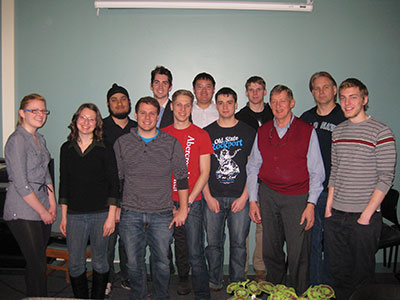
|
|
Sadly, this is also the last edition, as I have recently retired from the university.
Besides learning and understanding the basic principles of greenhouse production, the laboratory portion involves a research project.
For the student, it is a way to find out whether they like this type of inquisitive thinking.
The ideas for most projects over the years have their roots in the greenhouse industry. Many thanks are due to Albert Grimm, of Jeffery’s Greenhouses, who for many years has come up with some interesting questions that could be addressed by the students.
Of course, the results of these studies are not conclusive due to the time or greenhouse limitations, and there may be errors in the setup. So reader – be aware!
Main photo – Student researchers included, from left to right, Kayla Richard, Michelle Arsenault, Hardeep Singh, Jordan Sloggett, Tom Heeman, Evan Lewis, Kenny So, Justin Robson, Christopher Britton-Foster, Theo Blom (instructor), David Kerec (assistant), and Ben Van Dieten. Madeline Rodrigue was absent on the day of the picture taking.
The effect of pH on the efficacy of B9 on the growth and flowering of potted chrysanthemums
Christopher Britton-Foster and Justin Robson
 |
|
| Figure 1. Height and flower comparison of mum ‘Chesapeake’ sprayed with B-9 solutions adjusted to different pH levels.
|
B-9 (a.i. daminozide) is a plant growth regulator used by potted chrysanthemum (Dendranthema grandiflora)growers to reduce stem elongation and leaf area. Many studies have reported the effectiveness of B-9 at different concentrations, but there is a lack of information regarding the influence of pH on its efficacy. The present study tested the effectiveness of B-9 at controlling the height and flowering of two varieties of pot mums at pH levels of 3, 5 or 7. Control treatments of deionized water had the same pH levels.
There was no significant variation in height among the control treatments, confirming that differences in height for B-9 applications were caused by an interaction between B-9 and pH. Plant height and leaf size were significantly smaller for the B-9 treatment at pH 7 compared to the lower pH levels (Figure 1), with a slight delay in flowering.
Effects of air temperature and light quantity on the number of buds of Easter lilies
Kayla Richard and Kenny So
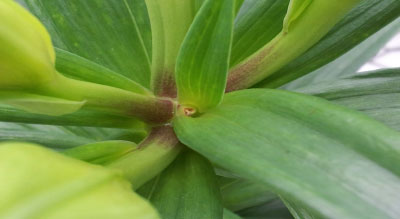 |
|
| Figure 2. Bud abortion in a ‘Nellie White’ Easter Lily.
|
In order to produce a crop of Lilium longiflorum Thunb., in time for an early Easter, growers will force Easter lilies by increasing air temperatures in the greenhouse. The objective of this study was to determine the effects of air temperature and light quantity on bud set and bud abortion in Easter lilies. Two different bulb sizes (7/8” and 8/9”) of lilies (cv. ‘Nellie White’) were grown in 15 C or 21 C greenhouses under 25 per cent shade or ambient light conditions during bud initiation (from Jan. 10 to Feb. 4). The results showed that the smaller bulbs had one less bud than the larger bulbs (4.0 vs. 5.0), but that temperature and light quantity had no effect on bud set. Furthermore, high temperatures in combination with small bulb size (7/8”) appeared to increase bud abortion (Figure 2) while light quantity did not affect bud abortion.
The effect of pH on effectiveness of Ethrel on seed geraniums (Pelargonium hortorum)
Hardeep Singh and Tom Heeman
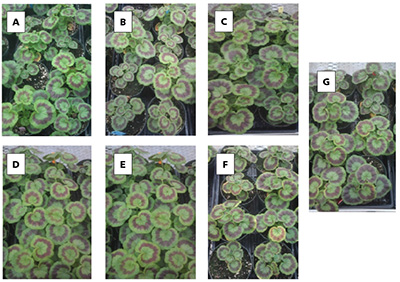 |
|
| Figure 3. The effects of two spray applications of different plant growth retardants on seed geraniums: Control (A), Ethephon at pH 3 (B), Ethephon at pH 6 (C), Ethephon at pH 5 (D), B-9 at 1,000 ppm (E), Cycocel at 1,000 ppm (F), and B-9/Cycocel combination (G).
|
Seed geraniums (Pelargonium hortorum)have become one of the more popular bedding plants, with common uses in landscape beds, hanging baskets and planters. Plant height is an important quality characteristic, when space is limited. The objective of this study was to determine the effectiveness of Ethrel (250 ppm) at different pH levels (pH of 3, 5 and 6) on seed geraniums. These spray treatments were compared with B-9 (1,000 ppm a.i. at pH of 4.1), Cycocel (1,000 ppm a.i. at pH of 4.4) and a B-9/Cycocel mixture at a pH of 4.0. There were two sprays applied (two weeks apart). The control plants were treated with de-mineralized water. The results indicated that plants were not shorter with the Ethrel application at pH 5.0 compared to the control (Figure 3). Furthermore, leaf area was comparable to the control. Plants performed best in the B-9/Cycocel mixture as plant height and internode length were reduced considerably, while the leaf area and the number of lateral buds were greater.
The effects of low-intensity radiation on the growth of winter and summer varieties of butterhead lettuce (Lactuca sativa) grown in the greenhouse
Michelle Arsenault

|
|
| Figure 4. Comparison of one butterhead lettuce winter variety (LB) with two summer varieties (BB and SB) showed that the winter variety (LB) produced a head with curling leaves in all treatments, greater leaf area than BB in 50 per cent shade, and greater leaf number in all treatments.
|
This study investigated the effects of low-intensity radiation on a winter variety of butterhead lettuce, Larissa Butterhead (LB), compared with two summer varieties, Sylvestra Butterhead (SB) and Buttercrunch Butterhead (BB). The three varieties were randomized in treatments using shade cloth to achieve zero shade, 30 per cent shade, and 50 per cent shade, and were grown at 18 C for 50 days. Visual observations showed that only LB could undergo heading in low intensity light (Figure 4). Quantitative results indicated that the winter variety LB had higher leaf area than BB in 50 per cent shade, and greater leaf number than both SB and BB, both of which are qualities selected for in winter variety breeding (Figure 4). However, fresh weights and specific leaf weights did not differ between the varieties.
Future breeding is required to select for increased fresh weight, yet, LB displayed morphology, which are criteria for consumer acceptance.
Rooting of chrysanthemum cuttings using combinations of IBA and B-9
Jordan Sloggett and Evan Lewis
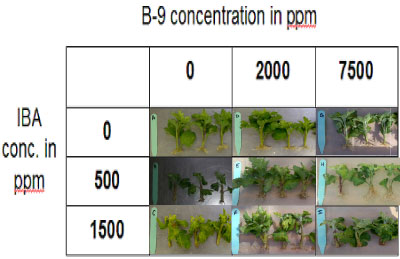
|
|
| Figure 5. The effect of submersing chrysanthemum cuttings in B-9 and IBA solution for 30 seconds before sticking. Note the phytotoxicity of a high concentration of IBA after two weeks of rooting.
|
Rooting and controlling vegetative growth can be beneficial for pot chrysanthemum growers. Chrysanthemum cuttings were dipped in solutions for 30 seconds with nine combinations of IBA and daminozide (B-9) concentrations in two experiments. In the first experiment, the factorial combinations of 0, 500 and 1,000 ppm of IBA with 0, 2000 and 5,000 ppm of B-9 using the cultivars ‘Annecy White’ and ‘Wood Pecker Gold’ were used. In the second experiment, it was 0, 500 and 1,500 ppm IBA in combination with 0, 2,000 and 7,500 ppm B-9 using the cultivars ‘Chesapeake’ and ‘Juneau.’ The cuttings were planted in perlite and allowed to root in a misting bed for 14 days. Rooting efficiency and cuttings height were assessed. High concentrations of either chemical alone or together produced poorly rooted cuttings with very little to no root development or excessive stubby root formation (Figure 5). If reduced vegetative growth is desired, it is recommended to use low concentrations of daminozide and IBA (less than 2,000 ppm and 500 ppm, respectively).
Prolonging vegetative growth of Begonia x hiemalis using red LED lighting
Madeline Rodrigue and Ben Van Dieten
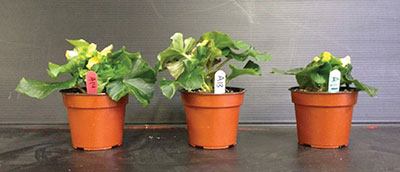 |
|
| Figure 6. Sample plants representing Amstel begonias grown under long days with night interruption using red LED (left) and incandescent (middle) lights. This is a control sample of Amstel begonias grown under short-day ambient conditions.
|
Long days delay flowering in begonias (Begonia x hiemalis), which are facultative short-day plants. Rieger begonia growers often use incandescent lights for night interruption in long-day regimes for reaching adequate size and vigour for meeting commercial market standards and supporting inflorescences. With incandescent lights exiting the market, an alternative light source is required. It was theorized that red LED lighting would be a viable alternative. Two treatments were designed to compare the effectiveness of incandescent (INC) and red LED lighting (LED) for night interruption (10 p.m. to 2 a.m.) using one cv. of the Rhine and Amstel series. Leaf area was measured along with fresh and dry weight, and the number of buds, flowers, leaves and nodes were counted. No statistically significant differences were found between the INC and LED treatments within the measured parameters (Figure 6). Our results showed no significant differences between the two light sources, so it supports the hypothesis that red LED lights can be used as a substitute for incandescent light bulbs.
Dr. Theo J. Blom is the recently retired instructor of the Greenhouse Crop Production course at the University of Guelph.
Print this page